 Support for Drupal 7 is ending on 5 January 2025—it’s time to migrate to Drupal 10! Learn about the many benefits of Drupal 10 and find migration tools in our resource center.
Support for Drupal 7 is ending on 5 January 2025—it’s time to migrate to Drupal 10! Learn about the many benefits of Drupal 10 and find migration tools in our resource center.Great Ormond Street Hospital (GOSH) is an international centre of excellence in child health care, and one of the UK’s biggest charities. The hospital website provides vital information to clinical professionals, parents and child patients. The charity depends on its website to support campaigns which look to raise £100m per year.
The hospital’s mission is to provide world-class clinical care and training, and to pioneer new research and treatments in partnership with other organisations for the benefit of children around the world.
The previous platform, a proprietary CMS, was hindering efforts towards achieving these goals. It could not handle substantial traffic loads, was difficult to edit, and was expensive to maintain. GOSH decided it was time for significant change, and reached out to CTI Digital for help.

Great Ormond Street Hospital Children’s Charity worked with an external agency to produce functional and non-fictional requirements documents through workshops and interviews with key stakeholders. GOSH reviewed the CMS market and reduced an initial long list of over 100 CMS down to 8:
- Umbraco
- Drupal 7
- Wordpress
- Jahia EE6
- Sitecore 7.0
- Autonomy
- site.com
- Adobe CQ
A scorecard was then produced with 26 ‘headline’ areas, made up of around 2-300 smaller requirements with agreed weighting from the requirements documents, and each marked against it. From this Drupal and Sitecore rose to the top – and we then took a deeper review of these two.
On reviewing functionality, hosting, support, costs (licensing, hosting and support) and resource availability (both agencies and staff), and bringing Acquia into the equation to provide the level of support we required on a 24x7 basis, Drupal edged ahead on several factors and was chosen.
Primary Objective
GOSH needed a single harmonised platform. This would be compiled from the migration of 2 large, business-critical sites (6,000 nodes and 30 content types per site), as well as 10 sub-sites to Drupal from an outdated proprietary software.
Secondary Objectives
- Scalable architecture - introduce infrastructure able to cope with sudden (and often unexpected) spikes in traffic levels following media coverage or fundraising campaign announcements
- Place digital as the axis - of all organisational activity
- Platform for innovation - Deliver ability to operate with business agility. GOSH needed something that was useful now and future ready
- Remove complexity - Remove interim solutions and proliferation of disconnected systems
- Time-saving tools - Achieve more with same number of staff
- Improve search - Paediatricians worldwide access this site for resources. Making it easier to use the medical conditions search was of vital importance
- Accessibility - Achieve exemplar accessibility compliance
GOSH’s mantra is “The Child First and Always”. CTI Digital set out with the objective that our solution would embody this principle.
Extended discovery phase
Discovery workshops conducted by business analysts, solution architects, and user experience designers resulted in establishing a comprehensive understanding of organisational goals. It also ensured GOSH made informed decisions about what was being proposed for their site. While this was at odds with the client’s preferred way of working of seeing code being written early on, we began the process with careful research and planning, which steered the project and led to success over the following months.
Agile Project Management
The cornerstone of the agile process is continuously adapting to change and getting feedback. As part of this process, our teams worked very closely together, focusing on assimilating feedback so that we could deliver the best possible product. We held regular sprint retrospectives internally, as well as frequent reviews with the client. Insight gained during both the retrospectives and reviews helped us remove impediments to delivery, respond to valuable user feedback, and reassess the scope of the project.
We managed the CMS and Migration projects in parallel. This helped to isolate the risk of the migration from the more predictable CMS build.
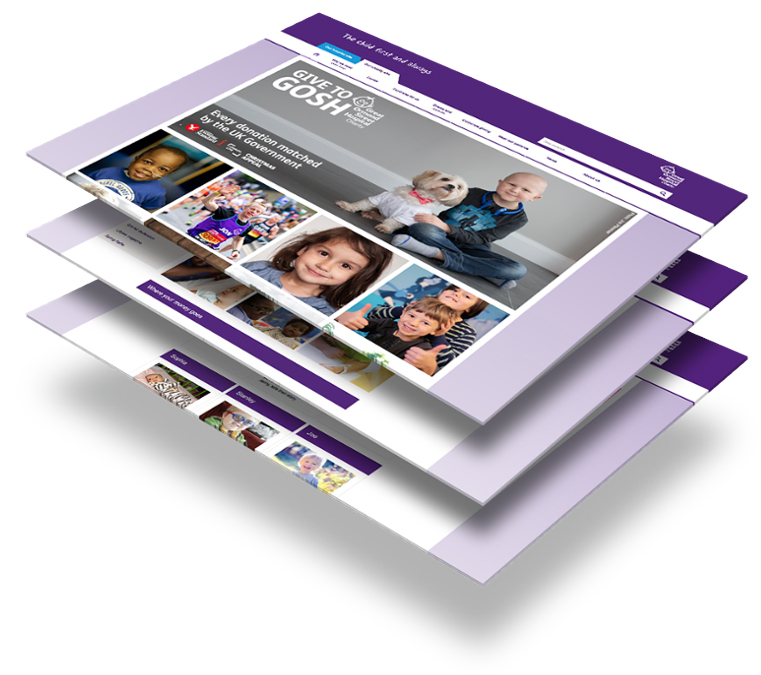
Accessibility and usability
The site is visited by a higher-than-average number of visitors with temporary and permanent visual impairments. Based upon advice provided to GOSH by RNIB, we implemented improved accessibility to achieve WCAG compliance.
Additionally, though it was not initially included in the project requirements, the team determined during discovery workshops that it would be imperative to include responsive design within the scope of work. We worked with GOSH to adapt their requirements to take advantage of Drupal’s existing functionality, which allowed us to expand the scope of the project to include responsive design without incurring any additional cost.
KPIs and performance
The entire project was steered by Key Performance Indicators that agreed with GOSH’s project board. These were metrics by which success was measured.
During every development sprint (and towards the culmination of the project) great emphasis was placed upon asserting that we robustly achieved results contributing toward the KPIs. For us, GOSH as a charity deserved the very best project outcomes.
Interruption-free migration
Orchestrating an interruption-free transfer between old and new systems, hospital critical digital services, and fundraising campaigns was a large undertaking. To ensure the transition occurred smoothly, we completed comprehensive planning with rollback strategies.
The source platform was a legacy .NET application that used a complex, undocumented MSSQL database with over 1000 tables. The content itself was stored in an unstructured, proprietary, and undocumented format. This required the reverse engineering of the legacy system’s rendering engine to retrieve the content in a format that could be migrated.
In addition to this, in order to migrate the previously-unstructured content into the new structured Drupal CMS, the content had to be split and parts extracted from each piece that was refactored into Drupal fields. Drupal Migrate module formed the basic framework for the migration. A specialist Drupal migration engineer spent nearly 6 months on the task, with the end result of a flexible, easy-to-access, easy-to-maintain content structure.
Atomic Design Principles
The 2 main websites (hospital and charity) have totally different objectives: facilitating patient visits and care, and fundraising. Presenting a cohesive design whilst addressing wildly different audiences demanded a smart approach.
Using StyleTiles afforded GOSH early access to our interpretation of their brand for both sites. Having over 15,000 pages between them, our interaction designers knew that the path to an effective visual design started with content modelling exercise, definition of user personas and journeys then rapid prototypes.

Enterprise Search
Fast, relevant search contributes to a good user experience. Medical professionals may need this information with critical urgency. Anxious parents and children are searching clinical guidelines and learning about medical conditions. A powerful, fast and relevant search was an important requirement.
With Drupal’s Search API and fine tuning available with Acquia Platform we have developed a single search code base, rationalise down from over 20 unique solutions, which delivers well and is sustainable for the future (many less lines of code).

Self-service notion
To make most effective use of staff and limited resources, GOSH needed a solution that provided excellent outcomes through self-service, and was not limited to patients.
Drupal’s highly adaptable administrative interfaces and powerful Workbench Moderation tools enabled us to tailor carefully considered administrative interfaces for the hundreds of content contributors, ranging from doctors to charity campaigners. This ultimately reduced training overhead.
Multi-sites / Sub Sites
GOSH maintains many microsites across its two larger sites. For example, there are microsites for specific fundraising campaigns, which causes site administration to be vastly complex-- not to mention that different interaction designs disrupted the user experience and contributed to an excess of code. As part of the redesign, it was determined that these microsites needed to be highly integrated into the larger sites themselves: operating from a shared code-base would reduce cost of ownership, and would allow new features to be more easily introduced to all microsites.
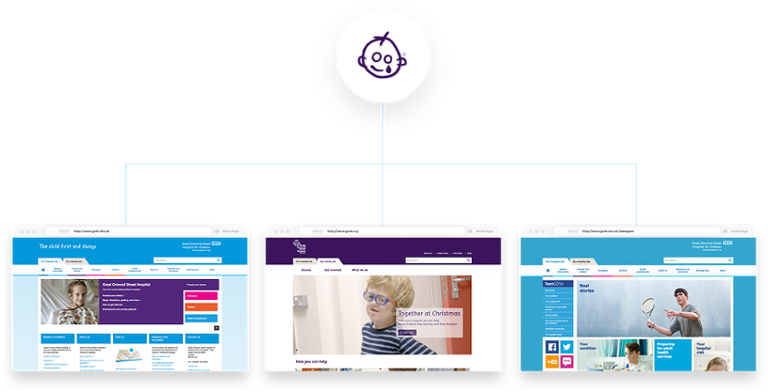
Results
Content and commerce can easily be intertwined, GOSH are no longer constrained by their CMS, indeed all options are open and being capitalised upon. Whilst discrete sites, the content management system is one and the same. Appropriate access privileges and flexible security boundaries are achieved using Drupal’s powerful Organic Groups module.
Personalisation is achieved by funnelling visitors rapidly to site sections and microsites designed for their needs. Each section adopts message, tone, imagery, content and even Solr Search is adapted to the appropriate audience. This is a living series of sites where stakeholders have regained control and are able to adapt the content regularly, keeping it relevant.
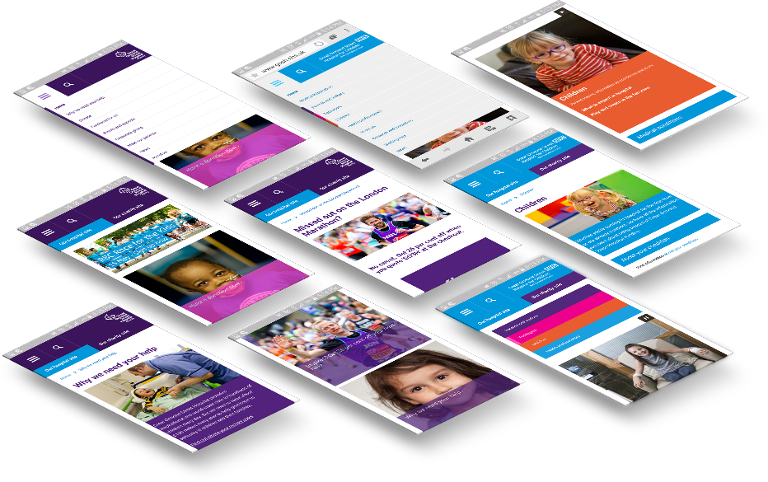
When comparing Drupal against the legacy system for the same period (May 2014/2015 - May 2015/2016):
- Visitor traffic rising - 13% increase in visits
- More donations - 11% improvement in conversion rate
- Loyalty ascending - 10% improvement on return visits
- Performance boost - average page download time down from 2800 ms to 1700 ms
- Mobile visits have rocketed - from 46% to 58%
- Design parameters exceeded 10 fold - performed under sustained traffic exceeding 10 times planned levels
Integrated Approach
Our solution promoted an integrated approach. Each sub-site is powered by common software. All sites inherit the same investment in responsive design, accessibility, usability, administrative efficiency.
The solution permits GOSH to quickly provision marketing and micro sites which promotes brand consistency:
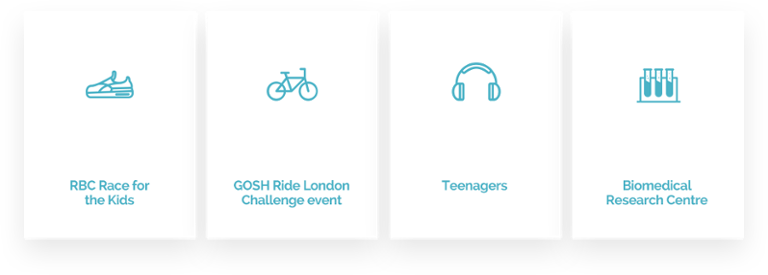
Acquia Cloud Infrastructure
With just 5 weeks notice the BBC announced scheduled broadcast of the latest of the prime time documentary series Great Ormond Street Hospital
Thanks to our Agile Development practice and upon Acquia Platform we achieved what was hitherto impossible - release a major new site section with integration to the JustGiving Fundraising API in a previously impossible time frame.
Beyond the seamless visitor experience, GOSH were able to capture valuable profile information about donors that the native JustGiving hosted pages do not offer. By doing so we are empowering GOSH to enhance their relationship with donors by providing intelligence fuelling personalisation.
Welcoming tremendous traffic surges
Not long after the launch of the new site, GOSH partnered with The London Evening Standard, The Independent and Transport for London on their fundraiser, Give to GOSH Appeal. The fundraiser was supported and endorsed by celebrities including Sir Paul McCartney, which led to a tremendous surge in public interest in the organisation’s work.
During the fundraiser, the site handled traffic levels exceeding the design parameters by 10 fold, and still remained performant. The positive organisational impact of this project, in the ability to realise modern multi-channel fundraising campaigns, cannot be overstated: between 24 November and 14 February, the website played its part in helping to raise £3.5 million across all of the charity’s fundraising channels.
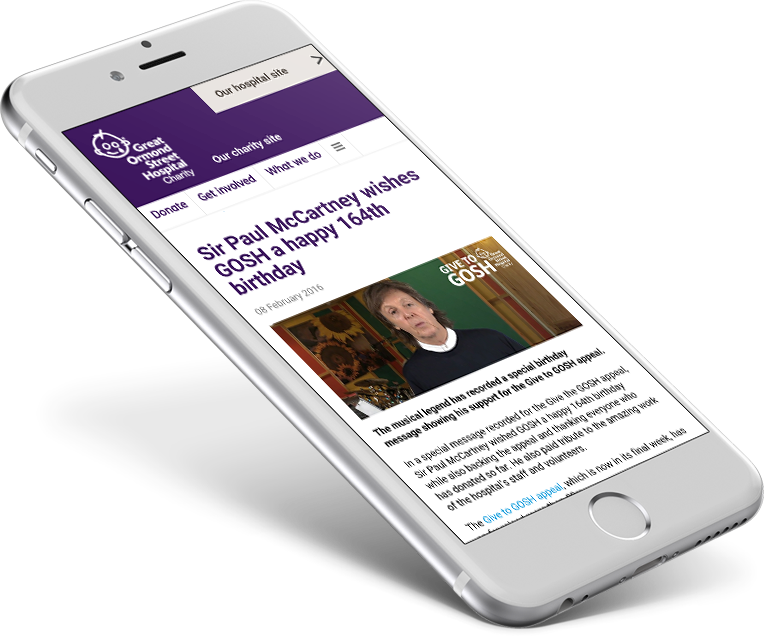
Drupal has allowed us to introduce fundraising journeys to the site in a flexible manner like never before. Naturally many patients become loyal supporters of the charity. Donate buttons and campaign calls to action can be subtly introduced within NHS hospital site, vice versa hospital content can be referenced to charity page .
Technical specifications
To make the best use of available budget and benefit the most from choosing open source GOSH expressed a preference to implement widely adopted Drupal modules as opposed create solutions specific to them. This allowed GOSH to collaborate with peers across charity and health sector.
Organic groups
Due to the distributed nature of content management responsibility across many roles within the hospital and charity, access to manage content needed to be provided on a highly granular level. This requirement was met by using the organic groups module to combine multiple content items into a group. This then allowed content management access permissions to be managed for the group as a whole. Authors and multiple levels of reviewers were assigned to content on this basis, which required close integration with the workbench moderation module.
Migrate
This project required a highly complex migration of unstructured content from a legacy content management system. The migrate module provided the obvious framework to create the scripts to automatically queried the legacy system, transformed the data extracted and saved it within the Drupal database.
Big menu
The GOSH websites use large menus hierarchies to enable users to navigate to content. These large menus cause the Drupal menu admin interface to become very slow, causing timeouts, as well as making reordering items very difficult. The Big menu module resolves this issue by modifying the user interface to only load the first level of the menu initially. The user can then expand menu items as required, to manage the items. This interface reduces the load on the server and makes the management of large menus significantly more usable.
Autosave
Due to the large number of content editors responsible for content on the websites, the administrative interface had to be highly usable in order to reduce training costs and enable users that infrequently manage content to work successfully. One of the key usability improvements to the content management forms was to enable the autosave module. This module automatically saves changes made to forms and restores these if users mistakenly navigate away from the forms. The autosave module is very quick to implement due to its "plug and play" nature, which makes it a very cost effective enhancement to Drupal's administrative interface.
A new Drupal 7 module was created to put powerful and time saving tools in the hands of content managers. The Lister module provides a new field type for Drupal 7, called "Listed content". It aims to provide an extendable method of allowing end users to create lists of content as they would any other field.
Lister fields are plugin based to allow for the list to be generated in multiple ways. Plugins included in submodules are EFQ (EntityFieldQuery), RSS, Views and Menu Children. A base class ListerPlugin is provided which can be extended for custom plugins.
For GOSH adopting an open source mentality and showing thought leadership to their peers was an important principle. We are delighted this module will soon be a Drupal project available for all.